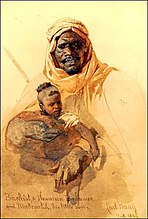| Carl Haag | |
|---|---|
 Carl Haag, Self-Portrait, 1900 Carl Haag, Self-Portrait, 1900 | |
| Born | 20 April 1820 Erlangen, Kingdom of Bavaria |
| Died | 24 January 1915(1915-01-24) (aged 94) Oberwesel, German Empire |
| Nationality | Bavarian-English |
| Education | Academy of Fine Arts Nuremberg and Munich |
| Known for | Painter, water-colourist |
| Movement | Orientalist |
Carl Haag (20 April 1820 – 24 January 1915) was a Bavarian-born painter who became a naturalized British subject and was court painter to the duke of Saxe-Coburg and Gotha.
Biography
Haag was born in Erlangen, in the Kingdom of Bavaria, and was trained in the Academy of Fine Arts Nuremberg and at Munich. He initially practised as an illustrator and as a painter in oils of portraits and architectural subjects; but in 1847 he settled in England, where he studied English watercolour techniques. After this he devoted himself to watercolours.
In 1850, he was elected an associate of the Royal Society of Painters in Water Colours before becoming a full member in 1853. He also enjoyed the patronage of Queen Victoria. Between 1858 and 1860, he travelled to the Middle East, at first staying for more than a year in Cairo where he shared a studio with fellow artist Frederick Goodall. Later he journeyed to Jerusalem, Lebanon and Syria before returning to Cairo. During this period, he made many sketches which he worked up into paintings after returning to London. He returned to Egypt in 1873–74 to gather inspiration for further Oriental paintings.
He was a prolific and important painter of Holy Land scenes. He gained a considerable reputation for his firmly drawn and meticulously elaborated paintings of Eastern subjects. Some of his depictions of the Middle East are in the Israel Museum's collection. In 1903, he retired and towards the end of his life, Haag left England and returned to the newly united German Empire, where he died in Oberwesel.
Selected works

- Evening in Balmoral
- The Sudden Shock in the Desert
- The Danger in the Desert
- The Ruins of Baalbek
- Panorama of Palmyra
- Beduin Devotion
- Ouposts in Montenegro
- Reading the Koran
- Morning in the Highlands
- Bachist, a Howazeen Bedawee and Mabzookh, his Little Son
- A Nubian harper
- Greek Warrior
- Abdullah, Chief of Said Pasha's Bodyguard
-
 A Nubian harper (1858)
A Nubian harper (1858)
-
 Greek Warrior (1861)
Greek Warrior (1861)
-
 Abdullah, Chief of Said Pasha's Bodyguard (1873)
Abdullah, Chief of Said Pasha's Bodyguard (1873)
-
 Bachist, a Howazeen Bedawee and Mabzookh, his Little Son (1857)
Bachist, a Howazeen Bedawee and Mabzookh, his Little Son (1857)
-
 Kieff Yaous! (Rest is sweet!) (1893)
Kieff Yaous! (Rest is sweet!) (1893)
-
 Well of souls, Dome of the Rock, Jerusalem (1859)
Well of souls, Dome of the Rock, Jerusalem (1859)
See also
Sources
 This article incorporates text from a publication now in the public domain: Chisholm, Hugh, ed. (1911). "Haag, Carl". Encyclopædia Britannica. Vol. 12 (11th ed.). Cambridge University Press. p. 780. This work in turn cites:
This article incorporates text from a publication now in the public domain: Chisholm, Hugh, ed. (1911). "Haag, Carl". Encyclopædia Britannica. Vol. 12 (11th ed.). Cambridge University Press. p. 780. This work in turn cites:
- John Lewis Roget, A History of the Old Water-Colour Society, now the Royal Society of Painters in Water Colours (two volumes, London, 1891)
References
- ^ Chisholm 1911.
- Khatib, H., Palestine and Egypt Under the Ottomans: Paintings, Books, Photographs, Maps and Manuscripts, I.B.Tauris, 2003, p. 101
External links
- Carl Haag in the German National Library catalogue
- 1820 births
- 1915 deaths
- 19th-century British painters
- Artists from the Kingdom of Bavaria
- Immigrants to the United Kingdom
- 19th-century German painters
- 20th-century German painters
- 20th-century German male artists
- Artists' Rifles soldiers
- Academy of Fine Arts, Nuremberg alumni
- British male painters
- German court painters
- German male painters
- German Orientalist painters
- 19th-century German male artists
- 19th-century British male artists